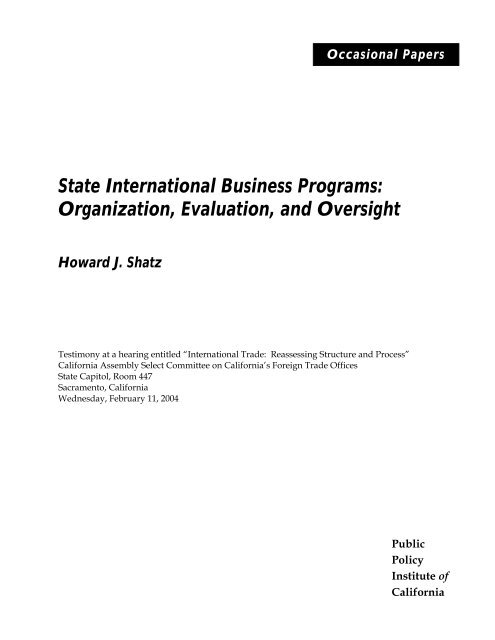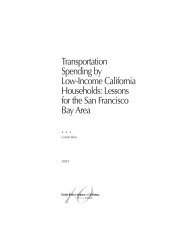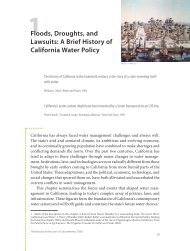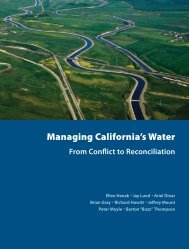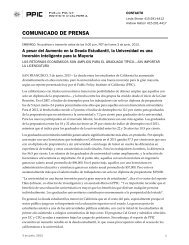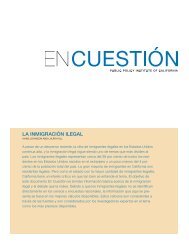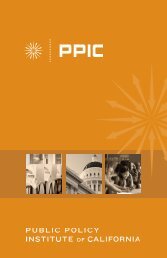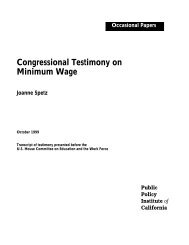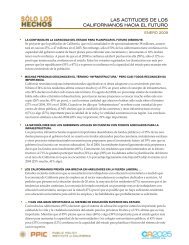Occasional Paper Title - Public Policy Institute of California
Occasional Paper Title - Public Policy Institute of California
Occasional Paper Title - Public Policy Institute of California
You also want an ePaper? Increase the reach of your titles
YUMPU automatically turns print PDFs into web optimized ePapers that Google loves.
<strong>Occasional</strong> <strong>Paper</strong>s<br />
State International Business Programs:<br />
Organization, Evaluation, and Oversight<br />
Howard J. Shatz<br />
Testimony at a hearing entitled “International Trade: Reassessing Structure and Process”<br />
<strong>California</strong> Assembly Select Committee on <strong>California</strong>’s Foreign Trade Offices<br />
State Capitol, Room 447<br />
Sacramento, <strong>California</strong><br />
Wednesday, February 11, 2004<br />
<strong>Public</strong><br />
<strong>Policy</strong><br />
<strong>Institute</strong> <strong>of</strong><br />
<strong>California</strong>
The <strong>Public</strong> <strong>Policy</strong> <strong>Institute</strong> <strong>of</strong> <strong>California</strong> (PPIC) is a private operating foundation established in 1994 with<br />
an endowment from William R. Hewlett. The <strong>Institute</strong> is dedicated to improving public policy in <strong>California</strong><br />
through independent, objective, nonpartisan research.<br />
PPIC's research agenda focuses on three program areas: population, economy, and governance and<br />
public finance. Studies within these programs are examining the underlying forces shaping <strong>California</strong>’s<br />
future, cutting across a wide range <strong>of</strong> public policy concerns, including education, health care,<br />
immigration, income distribution, welfare, urban growth, and state and local finance.<br />
PPIC was created because three concerned citizens – William R. Hewlett, Roger W. Heyns, and Arjay<br />
Miller – recognized the need for linking objective research to the realities <strong>of</strong> <strong>California</strong> public policy. Their<br />
goal was to help the state’s leaders better understand the intricacies and implications <strong>of</strong> contemporary<br />
issues and make informed public policy decisions when confronted with challenges in the future.<br />
David W. Lyon is founding President and Chief Executive Officer <strong>of</strong> PPIC. Raymond L. Watson is<br />
Chairman <strong>of</strong> the Board <strong>of</strong> Directors.<br />
Copyright © 2004 by <strong>Public</strong> <strong>Policy</strong> <strong>Institute</strong> <strong>of</strong> <strong>California</strong><br />
All rights reserved<br />
San Francisco, CA<br />
Short sections <strong>of</strong> text, not to exceed three paragraphs, may be quoted without written permission<br />
provided that full attribution is given to the source and the above copyright notice is included.<br />
PPIC does not take or support positions on any ballot measure or on any local, state, or federal<br />
legislation, nor does it endorse, support, or oppose any political parties or candidates for public <strong>of</strong>fice.<br />
Research publications reflect the views <strong>of</strong> the authors and do not necessarily reflect the views <strong>of</strong> the<br />
staff, <strong>of</strong>ficers, or Board <strong>of</strong> Directors <strong>of</strong> the <strong>Public</strong> <strong>Policy</strong> <strong>Institute</strong> <strong>of</strong> <strong>California</strong>.
Summary<br />
The demise <strong>of</strong> the <strong>California</strong> Technology, Trade, and Commerce Agency gives <strong>California</strong><br />
the opportunity to rethink its provision <strong>of</strong> international business services. Previously,<br />
<strong>California</strong> provided such services by helping firms export, attracting investment from overseas,<br />
guaranteeing export finance, and sponsoring overseas trade and investment <strong>of</strong>fices. The case is<br />
by no means certain that the state should be involved in providing such services. However,<br />
should the state decide to reenter the field, it will be helpful to recognize that in the current<br />
international business environment, a large share <strong>of</strong> international business activity occurs<br />
through networks, suggesting that it is advantageous for a business to be linked to these<br />
networks. Furthermore, businesses involved in one form <strong>of</strong> global engagement, for example,<br />
exports, are <strong>of</strong>ten involved in other forms.<br />
A justification for state involvement is that businesses, workers, and communities<br />
engaged with the global economy generally are more prosperous that those that are not. This<br />
does not mean global engagement brings unmitigated benefits, only that there is a tendency for<br />
the benefits to outweigh the costs. Should the state reconsider its approach to international<br />
business services, any program design should be built around the needs <strong>of</strong> clients – small and<br />
medium-sized enterprises as well as interested foreign investors – and around the wealth <strong>of</strong><br />
international business services already <strong>of</strong>fered in the state. Greater involvement <strong>of</strong> the private<br />
sector may be beneficial, and there are several models from which to choose. Foreign <strong>of</strong>fices<br />
may be a useful adjunct but must be linked to strong domestic support.<br />
Setting standards and evaluating performance will remain difficult, as they are for many<br />
state international programs around the United States. However, the state should avoid an<br />
oversight and evaluation system in which its <strong>of</strong>ficials are expected to take full credit for an<br />
export sale or some other international activity. Such activities are seldom the result <strong>of</strong> action<br />
by only one person or agency. Client surveys and external audits can be helpful for providing<br />
feedback and building credibility.<br />
Given limited budget resources, the state can treat the next half year as a planning<br />
period, reestablish a high-level <strong>of</strong>fice for international business, conduct an inventory <strong>of</strong> the<br />
services and gaps in services available to businesses statewide, and examine more rigorously<br />
which services the state’s small and medium enterprises would value.<br />
- iii -
State International Business Programs: Organization,<br />
Evaluation, and Oversight<br />
Thank you for inviting me to this important hearing. My remarks are based on research<br />
conducted at the <strong>Public</strong> <strong>Policy</strong> <strong>Institute</strong> <strong>of</strong> <strong>California</strong> (PPIC), an independent, nonpartisan<br />
research institute. PPIC does not take positions on legislation, but instead provides objective<br />
information for decision-makers and the general public as they consider policy issues.<br />
The research behind my testimony has included written sources, a modest amount <strong>of</strong><br />
statistical analysis, and interviews during the past two years with a variety <strong>of</strong> state trade<br />
directors and others involved in providing international business services. In my remarks<br />
today, I will first give an overview <strong>of</strong> the international economy and then discuss whether<br />
<strong>California</strong> should be involved with providing services related to international business. Finally,<br />
I will outline some specific considerations in the design <strong>of</strong> a program that provides such<br />
services.<br />
The nationwide community <strong>of</strong> state-level trade <strong>of</strong>ficials, U.S. trade <strong>of</strong>ficials, and even<br />
<strong>of</strong>ficials <strong>of</strong> foreign governments noticed the demise <strong>of</strong> the <strong>California</strong> Technology, Trade, and<br />
Commerce Agency (TTCA) in the current state budget. The end <strong>of</strong> the TTCA meant the end <strong>of</strong><br />
the <strong>California</strong> Export Finance Office, the Office <strong>of</strong> Export Development, the Governor’s Office <strong>of</strong><br />
<strong>California</strong>-Mexico Affairs, the Commission <strong>of</strong> the <strong>California</strong>s, and 12 foreign <strong>of</strong>fices. Some<br />
state-run international business programs remain in other agencies, such as <strong>California</strong> Business<br />
Investment Services (CalBIS) in the Employment Development Department, the Agricultural<br />
Export Program in the <strong>California</strong> Department <strong>of</strong> Food and Agriculture, and the Energy<br />
Technology Export Program in the <strong>California</strong> Energy Commission. However, the state’s action<br />
eliminated a great deal <strong>of</strong> <strong>California</strong>’s trade and investment promotion infrastructure.<br />
The elimination <strong>of</strong> these TTCA programs may present an opportunity. <strong>California</strong> hosts<br />
a large network <strong>of</strong> trade and investment facilitation organizations in addition to the remaining<br />
state programs. These include federal export assistance centers, four nonpr<strong>of</strong>it world trade<br />
centers, the Centers for International Trade Development at the <strong>California</strong> Community<br />
Colleges, and other governmental, nonpr<strong>of</strong>it, and for-pr<strong>of</strong>it organizations and businesses. A<br />
clean slate provides the opportunity for the state to reevaluate its policy stance towards<br />
international business services, and if it decides to provide those services, to think more<br />
carefully about how to integrate the many other organizations and take account <strong>of</strong> how<br />
international business is practiced in the 21 st century. <strong>California</strong> has set trends before, and this<br />
may be the opportunity to do so again.<br />
What Does the International Economy Look Like?<br />
Although much discussion <strong>of</strong> international business focuses on exports, the international<br />
economy encompasses many different types <strong>of</strong> business activities. In addition to exporting,<br />
many <strong>California</strong> businesses invest abroad, create joint ventures, license technology, and import<br />
raw materials, components, and capital equipment. Furthermore, foreign firms set up<br />
operations in <strong>California</strong> in the form <strong>of</strong> inward foreign direct investment (FDI), license their own<br />
- 1 -
technology to <strong>California</strong> firms, and view <strong>California</strong> as an inviting market for their products and<br />
services. 1<br />
Many <strong>of</strong> these modes <strong>of</strong> international business are linked (Table 1). In 2001, more than<br />
80 percent <strong>of</strong> all U.S. goods exports involved multinationals, companies that had engaged in<br />
FDI. They were sold either by U.S. multinationals or by companies based in the United States<br />
but owned by foreigners, or they were bought by foreign affiliates <strong>of</strong> U.S. companies. More<br />
than 37 percent <strong>of</strong> U.S. exports actually stayed within a single multinational business group. In<br />
the other direction, more than 70 percent <strong>of</strong> all U.S. goods imports involved either U.S.<br />
multinationals or foreign multinationals, and almost 48 percent stayed within multinational<br />
business groups. In addition, almost 24 percent <strong>of</strong> all U.S. services trade involved sales between<br />
parent companies and their foreign affiliates.<br />
Table 1<br />
U.S. Trade Associated with Multinational Business Groups, 2001<br />
U.S.<br />
multinationals<br />
Goods trade<br />
(% <strong>of</strong> all U.S. goods trade)<br />
U.S.-based<br />
foreign<br />
affiliates<br />
All<br />
multinationals<br />
Services trade<br />
(% <strong>of</strong> all U.S.<br />
services trade)<br />
All<br />
multinationals<br />
Exports 58.3 22.4 80.8 25.2<br />
Imports 37.9 32.4 70.3 21.8<br />
Notes: Goods trade includes trade within multinational business groups and trade by U.S. multinationals<br />
or U.S.-based foreign affiliates with unaffiliated companies. Services trade includes only trade within<br />
multinational business groups.<br />
Sources: Mataloni (2003), Zeile (2003), and U.S. Department <strong>of</strong> Commerce, Bureau <strong>of</strong> Economic Analysis<br />
(2004).<br />
The implication for <strong>California</strong> is that if the state intends to help its businesses compete in<br />
the global economy, programs shaped purely in terms <strong>of</strong> promoting exports and attracting<br />
investment will ignore the way the international economy actually works. True, businesses and<br />
the state can benefit from exports. However, there may be more to be gained from helping<br />
businesses join global production networks, find international partners for a variety <strong>of</strong><br />
purposes, and engage in all forms <strong>of</strong> global business.<br />
1 FDI is cross-border investment for the purpose <strong>of</strong> operating a business. NUMMI, or New United Motor<br />
Manufacturing, Inc., the General Motors-Toyota joint venture in Fremont, is one example <strong>of</strong> inward FDI.<br />
- 2 -
Should the State Be Involved?<br />
Researchers and government <strong>of</strong>ficials have long known that firms that export are<br />
stronger than those that do not. These firms have higher productivity, pay higher wages,<br />
employ more people, have higher sales, and have higher capital intensity – characteristics that<br />
any company would be pleased to have. In fact, new research is showing that companies<br />
engaged in a variety <strong>of</strong> modes <strong>of</strong> globalization are stronger. These modes include exports,<br />
investment in other countries, foreign backing in the form <strong>of</strong> foreign investment in domestic<br />
firms, licensing <strong>of</strong> technology, and even the use <strong>of</strong> imported components and capital goods. 2<br />
The evidence also suggests that workers who work in globally engaged firms have<br />
higher wages than those who do not. Furthermore, communities with globally engaged firms<br />
are also more prosperous. These results appear to hold on a cross-country basis. They also<br />
dovetail nicely with the facts <strong>of</strong> modern international business; different forms <strong>of</strong> global<br />
engagement are linked, even for small companies. A recent survey <strong>of</strong> 1,100 exporters<br />
nationwide found that 27 percent <strong>of</strong> the mid-size exporters also manufacture overseas, and 55<br />
percent import components or products from overseas. For small exporters, these proportions<br />
were 11 percent and 38 percent, respectively. 3<br />
This is not to say that there are no problems with global engagement. Inward direct<br />
investment, much sought after by states, can provide competition for domestic firms. No doubt<br />
to the chagrin <strong>of</strong> U.S.-headquartered auto manufacturers, the top selling cars in the United<br />
States in 2002 were the Toyota Camry and Camry Solara and the Honda Accord – Japanese<br />
nameplates manufactured in Kentucky and Ohio. 4 In addition, imports can displace workers,<br />
and foreign competition can hurt domestic industries and communities. Exporting can teach<br />
companies about foreign markets so they feel comfortable moving production out <strong>of</strong> the United<br />
States to better serve those markets. Yet research shows that in spite <strong>of</strong> the problems, firms,<br />
workers, and communities that are globally engaged generally do better than those that are not.<br />
The key question is whether firms that are already strong engage in international<br />
business or whether engaging in international business makes firms strong. Although more<br />
work needs to be done on this question, the evidence suggests that the causality runs in both<br />
directions. The best evidence focuses on exporting and shows that although good firms become<br />
exporters, exporting raises employment growth and the probability <strong>of</strong> survival <strong>of</strong> those firms. 5<br />
Other evidence suggests that exporting leads to higher industry-level productivity.<br />
A remaining question is whether the state can or should be involved in encouraging the<br />
internationalization <strong>of</strong> business. There is little strong evidence that state actions can increase<br />
the overall level <strong>of</strong> state exports. This is because most exports go through large firms whereas<br />
state programs focus on small firms, and because the state export data are not ideal measures <strong>of</strong><br />
the production <strong>of</strong> exports within a state. One state trade <strong>of</strong>ficial interviewed said, “We play at<br />
2 This research is reviewed in Lewis and Richardson (2001).<br />
3 Bremer, Penny, and Simsek (2002).<br />
4 Edmunds.com (2003), Honda Motor Co. (2003), and Kentucky Cabinet for Economic Development<br />
(2003).<br />
5 Bernard and Jensen (1999).<br />
- 3 -
the fringes. Never let anyone tell you we don’t play at the fringes.” There is somewhat<br />
stronger evidence that state action can help to attract foreign investment. 6<br />
Beyond the issue <strong>of</strong> effectiveness, there may be a debate about the proper role <strong>of</strong><br />
government: state action in this area will necessarily involve assistance to individual private<br />
businesses, and people can reasonably argue that this is not a role for the state. The<br />
counterargument is that such actions can bring benefits to workers and communities and may<br />
in a small way help the overall state economy. The choice to proceed is ultimately a political<br />
question, one about which research has little to say.<br />
How Can <strong>California</strong> Proceed?<br />
Suppose <strong>California</strong> policymakers decide that the state should somehow assist<br />
international business. How should they deliver this assistance? Unfortunately, there is no one<br />
model for state international business programs. Some states try to involve the federal<br />
government, whereas others prefer to remain self-contained. Some track dollar values <strong>of</strong><br />
exports or FDI, whereas others track activities or numbers <strong>of</strong> companies served. Some have<br />
networks <strong>of</strong> foreign <strong>of</strong>fices, whereas others have few or none. Because <strong>of</strong> the diversity <strong>of</strong><br />
options, I will review key points for a few selected topics.<br />
Who is the client and what are the tasks?<br />
Before any plans are made, it should be recognized that the primary clients <strong>of</strong> these<br />
programs would be individual private businesses. More specifically, the clients should be small<br />
and medium-sized goods and services producers because larger businesses have greater trade<br />
capacity and greater ability to pay private service providers. Recruiting FDI into the state may<br />
be an exception, and clients could be <strong>of</strong> any size. However, even with FDI, larger firms can<br />
more easily overcome investment barriers without state assistance, and smaller firms will need<br />
more guidance. Additional clients related to FDI will include developers, real estate<br />
pr<strong>of</strong>essionals, landowners, and industrial- and business-park landlords looking for new tenants,<br />
goods and services providers who want a foreign-client sector, and even local governments<br />
seeking new investment. Given that most clients will be private, and that most will be small<br />
and medium-sized businesses, it pays for the state to reach outside government to hear what<br />
those businesses actually want and which services they believe are missing.<br />
The 2002 National Export Strategy provides a good example <strong>of</strong> responding to the client. 7<br />
The strategy itself was built upon a survey <strong>of</strong> more than 3,000 small and medium-sized<br />
enterprises and meetings with more than 100 exporters, intermediaries, investors, and lenders. 8<br />
Regarding one export-promotion task, the strategy specified that the government should<br />
“include provision for customer focus groups as well as ongoing feedback from user groups<br />
who can provide insight into how well the efforts to improve access meet the needs <strong>of</strong> actual<br />
6 See Shatz (2003).<br />
7 Trade Promotion Coordinating Committee (2002).<br />
8 These results are reported more fully in Bremer, Penny, and Simsek (2002).<br />
- 4 -
users.” 9 Such a survey might be useful for the state in considering how to move forward. At<br />
the very least, the state should consult this survey.<br />
Based on what users say, the tasks the state could provide are many. In general,<br />
government can coordinate, convene, subsidize, and fill gaps in services that the market cannot<br />
provide; or it can provide services generally. More specifically, the state could monitor U.S.<br />
trade policy and lobby the federal government, and monitor foreign governments’ trade<br />
policies. It could inventory services provided by other groups and coordinate those services. It<br />
could teach firms how to export, help arrange export finance, and bring companies on trade<br />
missions and to trade shows. It could prospect for FDI, arrange venues where <strong>California</strong> firms<br />
can create partnerships with foreign firms, sponsor foreign <strong>of</strong>fices, and cooperate with foreign<br />
or domestic national, provincial, or state governments to do many <strong>of</strong> these tasks. The tasks<br />
could be aimed at small and medium-sized firms generally or focus on specific industries. For<br />
example, companies in services sectors may be a promising set <strong>of</strong> clients because international<br />
services trade is becoming more important, and relatively less services trade than goods trade<br />
goes through multinational business networks.<br />
Different states do different sets <strong>of</strong> these tasks. Whether <strong>California</strong> should do any or all<br />
<strong>of</strong> them will depend on the needs <strong>of</strong> <strong>California</strong> businesses and on the services currently<br />
provided. One thing states do have in common is that they actively seek feedback from<br />
businesses, and they tend to have <strong>of</strong>fices in different regions to <strong>of</strong>fer services statewide. States<br />
with programs that have a reputation for success also have continuity in leadership, and this<br />
could be accomplished with at least one high-level civil service position in the state’s<br />
international business infrastructure.<br />
<strong>Public</strong>-private partnerships and funding<br />
One <strong>of</strong> the possibilities mentioned for <strong>California</strong> has been a new public-private<br />
structure. There are certainly benefits to this approach, but there are also costs. The main cost<br />
is that such an approach probably will not remove a need for state financial contributions. State<br />
trade <strong>of</strong>ficials interviewed indicated that most public-private partnerships do not stint on their<br />
share <strong>of</strong> public funding. For example, Enterprise Florida, the Florida public-private economic<br />
development agency, is now being discussed as a possible model for <strong>California</strong>. Although<br />
Enterprise Florida can raise money through federal grants and must raise money through<br />
private contributions, it also received almost $10.8 million from the state <strong>of</strong> Florida for the 2003-<br />
2004 budget year. 10 A second cost <strong>of</strong> public-private partnerships is that if certain services were<br />
to be funded mainly by one or two donors, there could be the appearance that these services<br />
were tilting their benefits to the donors rather than to the general community.<br />
On the contrary side, benefits from public-private partnerships are that private-sector<br />
involvement can provide extra money, limit politicization, provide feedback and a constituency<br />
for programs, and improve the quality <strong>of</strong> programs. They can also bring about significant<br />
private sector support that can help encourage stability, pr<strong>of</strong>essionalism, political support, and<br />
continuity <strong>of</strong> activities.<br />
9 Trade Promotion Coordinating Committee (2002), p. 38.<br />
10 Florida Office <strong>of</strong> Program <strong>Policy</strong> Analysis and Government Accountability, Florida Government<br />
Accountability Report (2003).<br />
- 5 -
Bearing in mind that public-private structures can have both benefits and costs, let me<br />
note several examples, at least one <strong>of</strong> which should be familiar.<br />
• Although Enterprise Florida gets most <strong>of</strong> its money from the state<br />
government, it is required by legislation to generate $1 million in private<br />
contributions. Its 2003-2004 budget includes $1.6 million in private<br />
contributions and $1.2 million in revenues and fees for specific programs or<br />
sponsorships. Adding this to the $10.8 million state contribution results in a<br />
$13.6 million budget, with more than 25 percent coming from private<br />
sources. Enterprise Florida also administers state incentive programs and<br />
coordinates the activities <strong>of</strong> nearly 50 local and regional economic<br />
development organizations in the state. Business leaders at the chiefexecutive-<strong>of</strong>ficer<br />
level constitute a large majority <strong>of</strong> its board <strong>of</strong> directors.<br />
• A popular mode <strong>of</strong> private sector involvement is to have a state international<br />
trade council or commission that includes as members business people and<br />
public <strong>of</strong>fice holders. Certainly, this can become filled with appointees<br />
uninvolved with international business. One method <strong>of</strong> guarding against<br />
this problem is to allocate places automatically to universities, economic<br />
development councils, or business and industry groups – especially groups<br />
serving small and medium businesses – as some states do. Other states vest<br />
the state international trade council with oversight powers or the ability to<br />
appoint the pr<strong>of</strong>essional staff member in charge <strong>of</strong> economic development.<br />
• For eight years, <strong>California</strong> organized the Cal-IT conference in London and is<br />
now working to continue it. This was a trade, investment, and partnering<br />
forum for selected <strong>California</strong> technology companies and European<br />
technology companies and investors. Although formerly hosted by the nowclosed<br />
TTCA, the conference also relied on a European Technology Advisory<br />
Board <strong>of</strong> private companies that screened prospective participants on the<br />
basis <strong>of</strong> technology, management strength, business plan, and relevance to<br />
the European market. 11<br />
• Across the United States, Virginia has started an innovative program to<br />
provide intensive assistance to 30 exporters each year. Called VALET<br />
(Virginia Leaders in Export Trade), the program selects 15 companies every<br />
six months, grants them $10,000, gives $10,000 worth <strong>of</strong> services by private<br />
trade experts, provided for free to the state, and requires each VALET<br />
company to commit $20,000 towards export trade. The state then works<br />
intensively with them over two years. 12<br />
On funding, <strong>California</strong> should investigate methods <strong>of</strong> private funding while remaining<br />
aware <strong>of</strong> the conflict-<strong>of</strong>-interest problem I noted earlier. It may be possible to create a fund into<br />
which money may be contributed for unrestricted use by the state’s international business<br />
11 Cal-IT (2003).<br />
12 Virginia Economic Development Partnership, Division <strong>of</strong> International Trade (2003) and Virginia<br />
Economic Development Partnership (2004).<br />
- 6 -
programs. Donors will surely want something in return, and the state will have to be creative<br />
in giving something <strong>of</strong> value without compromising program integrity. Giving them a strong<br />
voice in the governance <strong>of</strong> the international business programs could be one such benefit.<br />
One other way <strong>of</strong> raising money is to charge fees for selected services. Experience<br />
shows this cannot be used to fund program operations completely. However, as in the<br />
Enterprise Florida example, it can help expand the budget. It can also have two other benefits<br />
for state programs. First it can act as a barrier to businesses that are not serious about global<br />
engagement. Second, it can signal to the state what programs private businesses believe are<br />
truly worthwhile.<br />
Cooperation and coordination across organizations<br />
As I stated earlier, <strong>California</strong> has a wealth <strong>of</strong> trade development organizations<br />
throughout the state. Given the state’s limited resources, now may be a good time for it to take<br />
an inventory <strong>of</strong> these organizations and then figure out which services are being provided and<br />
which are not. The state can then think about ways to cooperate with these organizations or to<br />
coordinate services. Cooperation can involve joint planning and service delivery or filling in<br />
service gaps rather than duplicating services. Coordination can involve acting as a<br />
clearinghouse for information on organizations, directing possible clients to different<br />
organizations, or even issuing requests for proposals from private service providers who could<br />
fill gaps in services. Memoranda <strong>of</strong> understanding between the state and other organizations<br />
can detail the rights and responsibilities <strong>of</strong> each.<br />
For example, <strong>California</strong> hosts 15 U.S. export assistance centers <strong>of</strong> the U.S. Commercial<br />
Service. These are responsible for boosting the exports <strong>of</strong> <strong>California</strong> companies and have links<br />
to the worldwide network <strong>of</strong> U.S. Department <strong>of</strong> Commerce foreign commercial <strong>of</strong>fices – more<br />
foreign <strong>of</strong>fices than <strong>California</strong> could ever hope to have. The state could formalize a partnership<br />
with them or even contract with them to carry out <strong>California</strong>’s export development. One state,<br />
for example, subsidizes companies from its state that use the Gold Key Service <strong>of</strong> the U.S.<br />
Commercial Service, a program that helps link exporters to potential markets.<br />
Some states and local trade groups elsewhere in the United States cooperate closely with<br />
the U.S. Commercial Service. Others coordinate their activities through periodic meetings.<br />
Others, however, expressed disappointment in the U.S. Commercial Service or believe that their<br />
state should retain control <strong>of</strong> export development. Still, it may pay for <strong>California</strong> to investigate<br />
cooperation, especially given budget realities.<br />
Aside from export development, various groups in the state may be able to work on<br />
other areas <strong>of</strong> global engagement, such as training firms to export and import, providing market<br />
information, or going on trade missions. At a minimum, the state could fulfill the role <strong>of</strong><br />
linking businesses with the various services by working as an information clearinghouse.<br />
No matter what types <strong>of</strong> alliances the state can form, two key modes <strong>of</strong> global<br />
engagement likely will remain under-served without direct state involvement. These are the<br />
attraction <strong>of</strong> inward FDI, and the sourcing <strong>of</strong> foreign components or capital equipment by<br />
<strong>California</strong> firms. FDI attraction will remain the largest gap for <strong>California</strong> because the state can<br />
be confusing to outsiders and because other states actively compete for foreign investment.<br />
- 7 -
Oversight, standards, and evaluation<br />
Although states generally house their international business programs in executive<br />
agencies or departments, state legislatures play a key role in providing oversight. This can<br />
involve setting standards and then relying on various evaluation methods to make sure the<br />
state’s programs are meeting those standards. Setting standards and evaluating the<br />
effectiveness <strong>of</strong> state <strong>of</strong>fices has been one <strong>of</strong> the biggest problems state international business<br />
programs face. One recent report noted:<br />
Measuring the effectiveness <strong>of</strong> state international trade programs is<br />
extremely difficult. Legislators have a duty to ensure that all state<br />
programs benefit their intended constituencies and use state dollars as<br />
efficiently as possible. However, in the absence <strong>of</strong> well-established<br />
standards for program evaluation, it is <strong>of</strong>ten tempting to set unrealistic<br />
goals. Mandating that programs achieve specific increases in state exports<br />
ignores the fact that state-by-state export data available from the Census<br />
Bureau is inherently flawed. Mandating that trade <strong>of</strong>fices help a specific<br />
number <strong>of</strong> companies over the course <strong>of</strong> a year encourages agencies to<br />
have superficial contacts with as many companies as possible, rather than<br />
providing in-depth assistance to particularly important sectors. 13<br />
Choosing the correct export metric is one example <strong>of</strong> the difficulties involved. If <strong>of</strong>ficials<br />
are evaluated based on the dollar value <strong>of</strong> exports they facilitated, they will have incentive to<br />
work only with large, established exporters – firms that may not need the state’s help. In<br />
addition, firms – even those that received valuable assistance – may be unwilling to report<br />
numbers. One state trade <strong>of</strong>ficial said, “They’re going to fudge; they’re going to make it up.”<br />
In fact, if the purpose <strong>of</strong> these programs is to strengthen the state’s economy, export<br />
levels may be the wrong criteria anyway. Research suggests that the gains from global<br />
engagement come from the fact <strong>of</strong> global engagement rather than the level <strong>of</strong> global<br />
engagement. 14 Therefore, the state may be better <strong>of</strong>f judging trade <strong>of</strong>ficials by the new exporters<br />
they help – companies that have never previously exported – or by entries into new markets by<br />
more experienced exporters.<br />
Here are examples <strong>of</strong> how other states measure their activities:<br />
13 Whatley (2003), p. 36.<br />
14 Lewis and Richardson (2001).<br />
• One state requires companies to report export sales six months, 12 months,<br />
and 18 months after receiving assistance. State <strong>of</strong>ficials then record the<br />
company’s market, its product, the state trade manager with whom it<br />
worked, the date <strong>of</strong> export sale, how the company reported the sale (for<br />
example, by telephone or e-mail), the dollar amount <strong>of</strong> the sale, and the type<br />
<strong>of</strong> assistance the state provided. It also monitors the value <strong>of</strong> inward FDI and<br />
employment by those foreign-owned companies that it has assisted. Based<br />
on an economic model, it then computes export-related jobs, and export- and<br />
FDI-related tax revenues.<br />
- 8 -
• Another state simply commits to work with a certain number <strong>of</strong> companies in<br />
each <strong>of</strong> its programs and then has its clients fill out evaluations.<br />
• Another state conducts only annual surveys <strong>of</strong> customer satisfaction.<br />
State trade <strong>of</strong>ficials and others involved with state trade promotion efforts recognize that<br />
it is <strong>of</strong>ten very difficult to determine credit for who actually was responsible for an export sale.<br />
However, they do recognize who the client is, and the interviews and my own research suggest<br />
that <strong>California</strong> should consider periodic surveys <strong>of</strong> firms that work with the state, perhaps<br />
carried out by an independent agency or company. <strong>California</strong> could also build into its<br />
programs a requirement for client companies to report levels and types <strong>of</strong> international business<br />
activity periodically. The state could encourage such reporting by providing financial<br />
incentives in the form <strong>of</strong> grants or reduced fees for services. Reporting requirements may<br />
discourage some clients, but they could encourage stronger relations with others. 15<br />
Another strategy would be much more involved but could go far toward answering the<br />
question <strong>of</strong> effectiveness. This is to build into the state’s international business programs a<br />
formal evaluation system in which a statistical evaluation specialist could analyze the programs<br />
every three years or so to answer whether firms that have been helped perform better than<br />
similar firms that have not been helped. Such evaluations have been done for other government<br />
activities, but to my knowledge they have not been carried out for state international business<br />
programs. If <strong>California</strong> were to do this, the state certainly would be setting a new standard for<br />
the nation.<br />
An immediate strategy for state international business assistance<br />
Given the variety <strong>of</strong> choices and the lack <strong>of</strong> money, one option is to treat the next six<br />
months or year as a planning period. The state could reestablish an <strong>of</strong>fice <strong>of</strong> international<br />
business or create an inter-agency coordination structure, perhaps answerable to the governor’s<br />
<strong>of</strong>fice, and then inventory the variety <strong>of</strong> international business services now being provided in<br />
<strong>California</strong>. This approach fits <strong>California</strong>’s current fiscal condition:<br />
These coordination structures need not consume a large amount <strong>of</strong> scarce<br />
resources. States don’t need foreign ministries; they just need<br />
mechanisms for inventorying and coordinating their international<br />
activities. The one indispensable ingredient in creating these mechanisms<br />
is executive leadership. 16<br />
Such an inventory would reveal not only what is present, but also what is missing. As<br />
part <strong>of</strong> this initial step, such an <strong>of</strong>fice could set up a comprehensive web portal <strong>of</strong> services and<br />
data, or collaborate with a private group in setting up such a portal. The international business<br />
15 Besides trade and investment data, the state may also want to collect data on current operations, such<br />
as the level <strong>of</strong> employment or sales, so that state <strong>of</strong>ficials can judge whether assistance is reaching small<br />
and medium-sized businesses rather than large businesses.<br />
16 Whatley (2003), p. 24.<br />
- 9 -
site <strong>of</strong> Enterprise Florida provides one such example. 17 The web sites <strong>of</strong> the <strong>California</strong> Centers<br />
for International Trade Development or <strong>of</strong> TradePort provide other models. 18<br />
A next step might be for such an <strong>of</strong>fice to survey <strong>California</strong> businesses to find out what<br />
kinds <strong>of</strong> services they actually need. Further information could be gathered from trade<br />
directors in other states – some <strong>of</strong> whom would be more than willing to talk to members <strong>of</strong> the<br />
<strong>California</strong> Legislature – and trade <strong>of</strong>ficials from foreign provincial, state, or national programs –<br />
many <strong>of</strong> whom are already based in <strong>California</strong>. Combining information about the existing<br />
landscape, the needs <strong>of</strong> the state’s businesses, and the types <strong>of</strong> services that others provide,<br />
<strong>California</strong> can then devise a new program that may prove more effective than previous models.<br />
Conclusion<br />
<strong>California</strong> has a great many options to consider should it again decide to <strong>of</strong>fer<br />
international business services. Please notice that I have mentioned very little about foreign<br />
<strong>of</strong>fices, the subject <strong>of</strong> much legislative and staff time over the past few years. Foreign <strong>of</strong>fices, be<br />
they state-run or contract, can be useful for a number <strong>of</strong> tasks. However, they also rely on<br />
strong staff support in their home state and work more effectively if their staffing and existence<br />
are uninterrupted. Discussion about a foreign <strong>of</strong>fice network may therefore be premature if it<br />
takes place before even thinking about whether <strong>California</strong> will have an international business<br />
function back home. Working without a Sacramento connection, <strong>California</strong> foreign <strong>of</strong>fices may<br />
once again become the object <strong>of</strong> doubts.<br />
Although the state has many choices regarding international business programs, it does<br />
not have many options regarding the nature <strong>of</strong> the international business environment. The<br />
international business environment is set by developments in communications and<br />
transportation technology, the economic growth <strong>of</strong> the United States and partner countries, and<br />
by U.S. and multilateral trade policy. <strong>California</strong> has little say in any <strong>of</strong> this, although it retains<br />
the seemingly underused right to try to influence federal trade legislation and policy.<br />
<strong>California</strong> developed innovative trade programs in the 1980s in response to the global<br />
environment and the needs <strong>of</strong> <strong>California</strong> businesses. A review <strong>of</strong> programs and services<br />
currently <strong>of</strong>fered throughout the state may clarify <strong>California</strong>’s policy options, especially in view<br />
<strong>of</strong> the differences between the international economy <strong>of</strong> today and that <strong>of</strong> the 1980s, the needs<br />
<strong>of</strong> <strong>California</strong>’s businesses, and the level <strong>of</strong> commitment state government can make. I hope my<br />
comments will help you determine how the state can best benefit from today’s global economy.<br />
Thank you.<br />
17 The Enterprise Florida international business site has separate links for information about FDI in<br />
Florida, the state’s international trade, and the Free Trade Area <strong>of</strong> the Americas; a list <strong>of</strong> foreign-affiliated<br />
companies in Florida; the 20 foreign trade zones in Florida; information about exporting assistance;<br />
Florida’s electronic trade leads network; information about Florida’s global linkages, such as consular<br />
<strong>of</strong>fices and sister-city relationships; Florida’s foreign <strong>of</strong>fices; and Enterprise Florida field <strong>of</strong>fices within<br />
the state that deal with international trade. The site can be accessed at www.eflorida.com.<br />
18 URLs are www.citd.org and www.tradeport.org.<br />
- 10 -
References<br />
Bernard, Andrew B., and J. Bradford Jensen, “Exceptional Exporter Performance: Cause, Effect,<br />
or Both?” Journal <strong>of</strong> International Economics, Vol. 47, No. 1, pp. 1-25.<br />
Bremer, Jennifer, Robert Penny, and Arda Simsek, Report Card on Trade II: Assessing the<br />
Effectiveness <strong>of</strong> U.S. Government Support to Small and Midsize Exporters (report no. PB 2002-105721,<br />
prepared under contract to the U.S. Department <strong>of</strong> Commerce, International Trade<br />
Administration), National Technical Information Service, Springfield, Virginia, 2002.<br />
Cal-IT, “FAQs [Frequently Asked Questions],” 2003, available at www.cal-it.com.<br />
Conway, Carol, and William E. Nothdurft, The International State: Crafting a Statewide Trade<br />
Development System, The Aspen <strong>Institute</strong>, Aspen, Colorado, 1996.<br />
Edmunds.com, “Top 10 Best-Selling Vehicles in 2002,” posted May 7, 2003, available at<br />
www.edmunds.com.<br />
Florida Office <strong>of</strong> Program <strong>Policy</strong> Analysis and Government Accountability, Florida<br />
Government Accountability Report, “Executive Office <strong>of</strong> the Governor: Enterprise Florida<br />
Inc.,” Tallahassee, Florida, September 18, 2003, available at www.oppaga.state.fl.us.<br />
Honda Motor Co., “Honda Auto Production Hits 10 Million Cars and Light Trucks in the U.S.,”<br />
November 25, 2003, available at world.honda.com.<br />
Kentucky Cabinet for Economic Development, “Automobile Production in Kentucky: 2002<br />
Statistics,” Frankfort, Kentucky, 2003, available at www.thinkkentucky.com.<br />
Lewis, Howard, III, and J. David Richardson, Why Global Commitment Really Matters! <strong>Institute</strong><br />
for International Economics, Washington, D.C., October 2001.<br />
Mataloni, Raymond J., Jr., “U.S. Multinational Companies: Operations in 2001,” Survey <strong>of</strong><br />
Current Business, November 2003, pp. 85-105.<br />
Shatz, Howard J., “Statement on State Foreign Offices,” <strong>Public</strong> <strong>Policy</strong> <strong>Institute</strong> <strong>of</strong> <strong>California</strong><br />
<strong>Occasional</strong> <strong>Paper</strong>, San Francisco, <strong>California</strong>, 2003.<br />
Trade Promotion Coordinating Committee, The 2002 National Export Strategy: The<br />
Administration’s Trade Promotion Agenda: Unlocking America’s Potential, Washington, D.C., 2002.<br />
U.S. Department <strong>of</strong> Commerce, Bureau <strong>of</strong> Economic Analysis, “Table E. Affiliated and<br />
Unaffiliated Trade in Services, 1997-2002, accessed February 2004, available at www.bea.gov.<br />
Virginia Economic Development Partnership, Division <strong>of</strong> International Trade, Annual Report,<br />
July 1, 2002 – June 30, 2003, Richmond, Virginia, 2003.<br />
Virginia Economic Development Partnership, “VALET Program,” Richmond, Virginia, 2004,<br />
available at www.exportvirginia.org.<br />
- 11 -
Whatley, Chris, State Official’s Guide to International Affairs, The Council <strong>of</strong> State Governments,<br />
Lexington, Kentucky, 2003.<br />
Zeile, William J., “U.S. Affiliates <strong>of</strong> Foreign Companies: Operations in 2001,” Survey <strong>of</strong> Current<br />
Business, August 2003, pp. 38-56.<br />
- 12 -
PUBLIC POLICY INSTITUTE OF CALIFORNIA<br />
Board <strong>of</strong> Directors<br />
Raymond L. Watson, Chairman<br />
Vice Chairman <strong>of</strong> the Board<br />
The Irvine Company<br />
Edward K. Hamilton<br />
Chairman<br />
Hamilton, Rabinovitz & Alschuler, Inc.<br />
Gary K. Hart<br />
Founder<br />
<strong>Institute</strong> for Education Reform<br />
<strong>California</strong> State University, Sacramento<br />
Walter B. Hewlett<br />
Director<br />
Center for Computer Assisted Research<br />
in the Humanities<br />
David W. Lyon<br />
President and CEO<br />
<strong>Public</strong> <strong>Policy</strong> <strong>Institute</strong> <strong>of</strong> <strong>California</strong><br />
Vilma S. Martinez<br />
Partner<br />
Munger, Tolles & Olson LLP<br />
Arjay Miller<br />
Dean Emeritus<br />
Graduate School <strong>of</strong> Business<br />
Stanford University<br />
Ki Suh Park<br />
Design and Managing Partner<br />
Gruen Associates<br />
Constance L. Rice<br />
Co-Director<br />
The Advancement Project<br />
Thomas C. Sutton<br />
Chairman & CEO<br />
Pacific Life Insurance Company<br />
Cynthia A. Telles<br />
Department <strong>of</strong> Psychiatry<br />
UCLA School <strong>of</strong> Medicine<br />
Carol Whiteside<br />
President<br />
Great Valley Center<br />
Cheryl White Mason<br />
Chief, Civil Liability Management<br />
Los Angeles City Attorney’s Office<br />
Advisory Council<br />
Mary C. Daly<br />
Research Advisor<br />
Federal Reserve Bank <strong>of</strong> San Francisco<br />
Clifford W. Graves<br />
General Manager<br />
Department <strong>of</strong> Community Development<br />
City <strong>of</strong> Los Angeles<br />
Elizabeth G. Hill<br />
Legislative Analyst<br />
State <strong>of</strong> <strong>California</strong><br />
Hilary W. Hoynes<br />
Associate Pr<strong>of</strong>essor<br />
Department <strong>of</strong> Economics<br />
University <strong>of</strong> <strong>California</strong>, Davis<br />
Andrés E. Jiménez<br />
Director<br />
<strong>California</strong> <strong>Policy</strong> Research Center<br />
University <strong>of</strong> <strong>California</strong><br />
Office <strong>of</strong> the President<br />
Norman R. King<br />
Executive Director<br />
San Bernardino Associated Governments<br />
Daniel A. Mazmanian<br />
C. Erwin and Ione Piper Dean and Pr<strong>of</strong>essor<br />
School <strong>of</strong> <strong>Policy</strong>, Planning, and Development<br />
University <strong>of</strong> Southern <strong>California</strong><br />
Dean Misczynski<br />
Director<br />
<strong>California</strong> Research Bureau<br />
Rudolf Nothenberg<br />
Chief Administrative Officer (Retired)<br />
City and County <strong>of</strong> San Francisco<br />
Manuel Pastor<br />
Pr<strong>of</strong>essor, Latin American & Latino Studies<br />
University <strong>of</strong> <strong>California</strong>, Santa Cruz<br />
Peter Schrag<br />
Contributing Editor<br />
The Sacramento Bee<br />
James P. Smith<br />
Senior Economist<br />
RAND Corporation
PUBLIC POLICY INSTITUTE OF CALIFORNIA<br />
500 Washington Street, Suite 800 San Francisco, <strong>California</strong> 94111<br />
Phone: (415) 291-4400 Fax: (415) 291-4401<br />
www.ppic.org info@ppic.org


